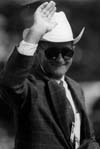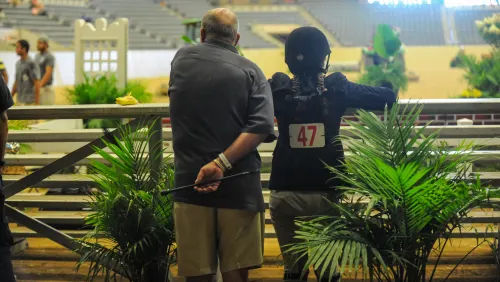 Now that I’m officially in the role as our team’s chef d’equipe, I’ve compiled a list of directions I give my riders on tours to other countries. This list isn’t in any particular order, but they’re all points that mean a lot to me. And the list keeps growing!
Now that I’m officially in the role as our team’s chef d’equipe, I’ve compiled a list of directions I give my riders on tours to other countries. This list isn’t in any particular order, but they’re all points that mean a lot to me. And the list keeps growing!
Yes, I am old-fashioned and set in my ways. I’m a product of the 1950s and of Bertalan de Nemethy, who was a gentleman, horseman, rider, trainer, coach, and chef d’equipe of the highest class. One can only try to emulate Bert. Much of what I do around horses, especially on the international scene, I learned from three men: Bert de Nemethy, Bill Steinkraus and my predecessor, Frank Chapot.
Responsibility–When riding for our country, it’s not a “me” thing. You have a responsibility to the American people, to your federation, and to your teammates (as well as to your chef).
Pay your bills–In years past, people have skipped town owing money. That’s bad enough at home, but on a team representing America, it reflects on us all. It simply cannot happen.
Know your FEI rule books–and the prize lists for each show, backward and forward. Frank has always really known his rules, and he’s saved us on many occasions.
Turnout–As you all know, I am a stickler about turnout. I use Bill Steinkraus and Michael Matz, two of our heroes, as examples of “spit-and-polish” horsemen. I abhor sloppiness and dirtiness of any kind, and I believe that it carries over into riding, training, and performance. The turnout and deportment of the riders, grooms, owners, and friends is all-important to me. And, as a rule, the nouveau European style doesn’t do much for me.
“We are always the underdog”–This principle must never be forgotten. North America is almost an outpost of civilization as far as equestrian sport is concerned. Northern Europe is the center. We have to fight harder than the Europeans to keep up, let alone beat them.
The mini-team concept–It takes five really good “mini-teams” to make up a really good big team. A mini-team isn’t just the rider, but his whole support group (owners, significant others, grooms, vets, blacksmiths, etc.). Invariably, the best result on a consistent basis belongs to the best mini-team.
Tack room–Like at home, the tack room set up is very important to me. There are two differences: First, it is a U.S. tack room. Second, it is a much simpler set up, having as much U.S. equipment as possible and as little personal equipment as is practical. It must be streamlined, neat and tidy at all times, and in no way a “rag-tag” operation. Walkie-talkies, as well as cell phones, are indispensable in Europe. The stabling is often far, far from the arena, and horses must go in the correct order.
Having an assistant secretary at a big international show is almost mandatory today. Between the paperwork, score-keeping and social directives, it’s practically a full-time job. Having this personal assistant certainly frees up a chef to do his job–walking the courses, watching the horses school, and being at the in-gate.
The veterinary inspection, or “jog,” is so important. One doesn’t realize how important until a horse is “spun” because of unsoundness. Always take the job extremely seriously. Horses and riders must be turned out in a neat and tidy manner, out of respect for the show, the veterinarians, and the judges.
At an international show with the team, riders, trainers and owners do not play vet, like at home. The official team veterinarian plays vet. I always insist on having a team veterinarian at large international shows. That’s the best way to protect the horses, make sure the rules are followed, and have a liaison with the official show veterinarians and the ground jury.
ADVERTISEMENT
It’s written into the U.S. Equestrian Federation rules and contracts that, once selected for an official team, the horses and riders come under the control of the chef d’equipe, especially in regard to schooling. This isn’t quite as all-encompassing as it might sound, but I certainly keep an eye on schooling and soundness. Americans tend to practice-jump too much. I abhor over-jumping horses. It makes them sore, stale, and careless at their fences.
Jumpers (hunters too) must be sharp to win. They have to jump “up” and not rub the fences. This takes three things: good management, good training techniques, and good riding.
Why do I insist on horses being braided for the Nations Cup and the grand prix (and possibly other big classes)? First, because it looks better, out of respect for the horse and the sport. And, second, I believe that, due to association, horses jump better and sharper when braided.
Remember that Europeans, especially the officials, are more formal than Americans. The whole world has become a sloppier place, but especially America. Europeans still like formality. Remember, “When in Rome, do as Romans do!”
I’m a great believer in carrying a whip when jumping. One doesn’t need to use it, but it’s there if you get in trouble. Any rider should be able to carry and properly use a whip. And any horse, well-schooled, should be able to accept a whip.
Work backwards when training horses. At a show, remember the last day of the show during the early part of the show. At circuits, like Indio (Calif.), Palm Beach (Fla.), or Ocala (Fla.), remember the really big classes are at the end, not the beginning.
The one thing Chris Kappler and I did with Royal Kaliber was not ruining him. For four years, we worked backwards from the 2004 Olympic Games. The serious contenders should now be working backwards from the 2006 World Equestrian Games in Aachen (Germany).
Like being the custodian of any show stable, going abroad with the team is an exercise of promotion. We are promoting ourselves to the horse show, its officials, the spectators, television, and the press. It’s also an opportunity to attract new owners and sponsors who might buy a horse or contribute to the USEF or the USET Foundation. My point–especially to the riders–is to extend yourselves, dress well, and be polite.
What is an international rider? First, he or she is someone with a burning desire to ride internationally at the highest level, right up to the Olympics. He or she must cultivate owners who can buy, often multiple, horses with ability. An international rider really should have at least one “string” of two grand prix horses, plus one speed horse.
The management of this caliber of a horse is often more sophisticated. One’s priorities often differ from that of a strictly national rider. There have always been some people who do better at home than in Europe and vice-versa. International riders at the top level are real professionals.
When signing onto a team, one commits to being truly part of that team. I want a group effort, not just an individual effort. Travel together, eat together, ride together, and sit together, at least as much as possible.
There never should be alcohol or drugs of any kind at the barn. It’s bad horsemanship, and it looks offensive.
ADVERTISEMENT
Be aware of the 45-second countdown clock when entering the ring. It can be very costly.
Americans, historically, have not always been very good at jumping the open water. Learn how to ride the water and how to train the water. Horses must be alert and not step on the tape. Our biggest problem at the Athens Olympics was jumping the water.
Going to Europe and jumping with “the big boys and girls” is a reality check. It’s the only reality check to be faced before you reach the Olympics or World Championships, save the Spruce Meadows Masters (Calgary, Alta.) in September. Palm Beach, Indio, our summer shows, and the summer Spruce Meadows shows are all preparatory to this reality check. I like reality checks!
I’m not a fan of any of these new-fangled stirrups. They either don’t shine, bend, or are too light and are hard to retrieve when lost. Keep them if you love them. But I like the old-fashioned, stainless steel, heavy duty, and straight stirrup irons.
European riders, as a rule, are fitter than we are. They’re “harder.” You and your horses must “harden up” if you want to be competitive in Europe. It’s very apparent when showing in Europe or at the Spruce Meadows Masters.
Many of the top horses in the world today are American-owned, yet ridden by foreigners, mainly European. Yes, these relationships develop for various, and often valid, reasons. But the bottom line is people like to be associated with winners. If we’d start winning more consistently internationally, we’d have more of those “expatriate” horses.
When showing any horse at any time at any horse show, one must be specific in intention. Are you trying to win the class, just going for a ribbon, or just plain schooling? There are just these three choices, although sometimes one’s plans change during a round.
There are contracts owners and riders must, and should, sign before embarking on a tour. It’s a commitment to certain principles. One is a guarantee to keep the horse through the duration of the tour and not sell him midstream.
And don’t sue. Nice people don’t sue. A family who wouldn’t dream of suing brought me up. It simply wasn’t done.
Owners, and other members of the en-tourage–we (the USEF) are not travel agents. We will guide and help, but that’s beyond the scope of our jobs. I myself make all of my own travel arrangements with my own travel agent. I’m more confident doing it that way.
I feel strongly about this list of pointers, policies and principles. And I’m sure this list will grow, but while I’m at the helm, I will guarantee to implement them as best I can.














